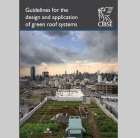Green roofs for our cities

‘Guidelines for the design and application of green roof systems’ has been published by CIBSE and can be ordered through the knowledge portal (see below). The author is Dr Sam C. M. Huil, who describes in his foreword how many cities in the world are facing the problems of urban heat islands and a lack of green space.
Green-roof systems, living vegetation installed on roofs, have been recognised as performing a vital role in helping cities adapt to the effects of climate change by reducing the need for artificial cooling in hot weather. They also attenuate or capture rainwater runoff and provide a range of habitats for urban wildlife.
However, the market for green roofs is still developing, and more information and understanding on their technical design, effectiveness and actual benefits is needed.
The guidelines from CIBSE cover scope, definitions, planning requirements, design considerations, construction methods, maintenance issues and project management for green-roof systems.
In the UK, green roof systems have been installed on homes, schools and office buildings. Many of the scenarios described in the guidelines are based on experiences in both Hong Kong and China, and demonstrate how green roof systems have become embraced internationally as a new option for building services engineers to consider, particularly in city environments.







